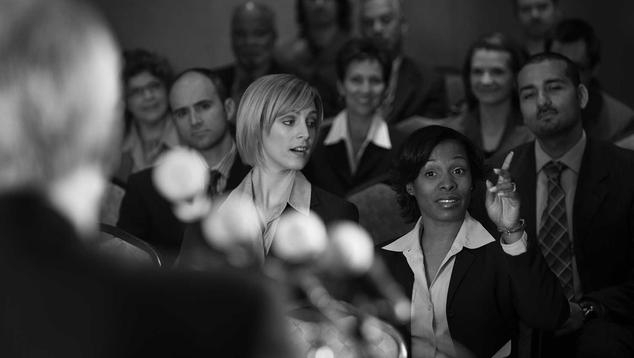Story Highlights
- 75% say news organizations should increase diversity on their staffs
- Views of where diversity efforts should focus vary by race, party
- General views of media drive views of how well it is handling diversity
Update: On Nov. 9, 2020, Gallup updated the report American Views 2020: Trust, Media and Democracy to correct a methodological error. The changes do not alter the underlying integrity of the data nor the conclusions. However, specific numbers have changed for a range of results and have been updated in this post. Learn more.
WASHINGTON, D.C. -- A solid majority of Americans say it is important for the news media to reflect the diversity of the U.S. population, and even more think news organizations should hire with diversity in mind. Yet, they disagree as to what kind of diversity they would like to see, according to a survey of 20,000 U.S. adults conducted Nov. 8, 2019-Feb. 16, 2020. These findings, part of the Gallup/Knight Foundation research series on Trust, Media and Democracy, explore Americans' views of diversity in newsrooms and news coverage and their desire for changes in both.
Overall, 69% of Americans say that reflecting the diversity of the U.S. population is a "critical" (33%) or "very important" (36%) role for the media. Black (44%), Hispanic (40%) and Asian people (38%) are more likely than White people (29%) to say the media's role in reflecting diversity is "critical." And while 44% of Democrats say the same, just 31% of independents and 23% of Republicans agree.
The survey was conducted prior to the current period of greater awareness of racial disparities and injustices following the killing of George Floyd, widespread protests seeking racial equity and justice in the U.S. and the national soul-searching that has followed in communities and newsrooms around the country.
Among those who say news organizations should hire for greater diversity, their highest priorities are to increase diversity based on race/ethnicity (34%) or political views (30%), followed by income or social class (17%), age (10%) and gender (6%).
The priorities Americans place on the kind of diversity they would most like to see differ greatly by race and political leaning. Racial minorities wanting increased diversity in newsrooms are more likely to place the priority on racial/ethnic diversity compared with Whites. A majority of Blacks (56%) and more than four in 10 Hispanics (43%) and Asians (47%) most want to see increased racial diversity in news organizations, compared with just 26% of Whites.
The partisan divide in these responses is also striking. About half of Republicans (48%) who want news organizations to increase their diversity say political diversity is most important, while 18% say racial/ethnic diversity matters the most. Conversely, about half of Democrats (47%) say racial/ethnic diversity matters to them the most, while 18% say political diversity is the greatest priority.
| Race or ethnicity | Political views | Income or social class | Age | Gender | ||||||||||||||||||||||||||||||||||||||||||||||||||||||||||||||||||||||||||||||||||||||||||||||||
|---|---|---|---|---|---|---|---|---|---|---|---|---|---|---|---|---|---|---|---|---|---|---|---|---|---|---|---|---|---|---|---|---|---|---|---|---|---|---|---|---|---|---|---|---|---|---|---|---|---|---|---|---|---|---|---|---|---|---|---|---|---|---|---|---|---|---|---|---|---|---|---|---|---|---|---|---|---|---|---|---|---|---|---|---|---|---|---|---|---|---|---|---|---|---|---|---|---|---|---|---|
| % | % | % | % | % | ||||||||||||||||||||||||||||||||||||||||||||||||||||||||||||||||||||||||||||||||||||||||||||||||
| U.S. adults wanting increased diversity in news organizations | 34 | 30 | 17 | 10 | 6 | |||||||||||||||||||||||||||||||||||||||||||||||||||||||||||||||||||||||||||||||||||||||||||||||
| Race/Ethnicity | ||||||||||||||||||||||||||||||||||||||||||||||||||||||||||||||||||||||||||||||||||||||||||||||||||||
| Whites | 26 | 34 | 19 | 11 | 6 | |||||||||||||||||||||||||||||||||||||||||||||||||||||||||||||||||||||||||||||||||||||||||||||||
| Blacks | 56 | 16 | 12 | 8 | 4 | |||||||||||||||||||||||||||||||||||||||||||||||||||||||||||||||||||||||||||||||||||||||||||||||
| Hispanics | 43 | 25 | 14 | 7 | 8 | |||||||||||||||||||||||||||||||||||||||||||||||||||||||||||||||||||||||||||||||||||||||||||||||
| Asians | 47 | 26 | 18 | 6 | 2 | |||||||||||||||||||||||||||||||||||||||||||||||||||||||||||||||||||||||||||||||||||||||||||||||
| Party identification | ||||||||||||||||||||||||||||||||||||||||||||||||||||||||||||||||||||||||||||||||||||||||||||||||||||
| Democrats | 47 | 18 | 18 | 8 | 6 | |||||||||||||||||||||||||||||||||||||||||||||||||||||||||||||||||||||||||||||||||||||||||||||||
| Independents | 31 | 30 | 21 | 10 | 4 | |||||||||||||||||||||||||||||||||||||||||||||||||||||||||||||||||||||||||||||||||||||||||||||||
| Republicans | 18 | 48 | 13 | 12 | 6 | |||||||||||||||||||||||||||||||||||||||||||||||||||||||||||||||||||||||||||||||||||||||||||||||
| Percentages among those who think news organizations should increase diversity in their staffs. "No answer" percentages not shown. | ||||||||||||||||||||||||||||||||||||||||||||||||||||||||||||||||||||||||||||||||||||||||||||||||||||
| Gallup/Knight Foundation, Nov. 8, 2019-Feb. 16, 2020 | ||||||||||||||||||||||||||||||||||||||||||||||||||||||||||||||||||||||||||||||||||||||||||||||||||||
The public has a mixed reaction when it comes to how well the media are doing with diversity efforts. A quarter of Americans (25%) think newsrooms are doing "very well" or "well," while about four in 10 (37%) think the media are doing "poorly" or "very poorly."
These views largely flow from Americans' overall opinion of the media -- those who have a positive image of the news media overall are more positive than negative about how well it reflects U.S. diversity, while those who view the media negatively are most negative on its reflection of the nation's diversity.
Most partisan, racial and ethnic subgroups are more likely to say the media is doing poorly rather than doing well reflecting U.S. diversity. A statistical model taking into account a variety of demographic and attitudinal factors finds that opinion of the news media overall is what drives ratings of how well it is doing reflecting diversity. Blacks and Democrats are somewhat less negative, but this is a function of those groups' more positive opinions of the news media in general. Race and party do not have an independent effect.
| Very well/Well | Acceptably | Poorly/Very poorly | Net (Total % Well-Total % Poorly) | |||||||||||||||||||||||||||||||||||||||||||||||||||||||||||||||||||||||||||||||||||||||||||||||||
|---|---|---|---|---|---|---|---|---|---|---|---|---|---|---|---|---|---|---|---|---|---|---|---|---|---|---|---|---|---|---|---|---|---|---|---|---|---|---|---|---|---|---|---|---|---|---|---|---|---|---|---|---|---|---|---|---|---|---|---|---|---|---|---|---|---|---|---|---|---|---|---|---|---|---|---|---|---|---|---|---|---|---|---|---|---|---|---|---|---|---|---|---|---|---|---|---|---|---|---|---|
| % | % | % | pct. pts. | |||||||||||||||||||||||||||||||||||||||||||||||||||||||||||||||||||||||||||||||||||||||||||||||||
| Americans overall | 25 | 33 | 37 | -12 | ||||||||||||||||||||||||||||||||||||||||||||||||||||||||||||||||||||||||||||||||||||||||||||||||
| Opinion of news media | ||||||||||||||||||||||||||||||||||||||||||||||||||||||||||||||||||||||||||||||||||||||||||||||||||||
| Positive | 46 | 34 | 18 | +28 | ||||||||||||||||||||||||||||||||||||||||||||||||||||||||||||||||||||||||||||||||||||||||||||||||
| Neutral | 27 | 43 | 29 | -2 | ||||||||||||||||||||||||||||||||||||||||||||||||||||||||||||||||||||||||||||||||||||||||||||||||
| Negative | 12 | 30 | 56 | -44 | ||||||||||||||||||||||||||||||||||||||||||||||||||||||||||||||||||||||||||||||||||||||||||||||||
| Race/Ethnicity | ||||||||||||||||||||||||||||||||||||||||||||||||||||||||||||||||||||||||||||||||||||||||||||||||||||
| Whites | 22 | 35 | 39 | -17 | ||||||||||||||||||||||||||||||||||||||||||||||||||||||||||||||||||||||||||||||||||||||||||||||||
| Blacks | 35 | 28 | 31 | +4 | ||||||||||||||||||||||||||||||||||||||||||||||||||||||||||||||||||||||||||||||||||||||||||||||||
| Hispanics | 35 | 28 | 32 | +3 | ||||||||||||||||||||||||||||||||||||||||||||||||||||||||||||||||||||||||||||||||||||||||||||||||
| Asians | 26 | 39 | 32 | -6 | ||||||||||||||||||||||||||||||||||||||||||||||||||||||||||||||||||||||||||||||||||||||||||||||||
| Party identification | ||||||||||||||||||||||||||||||||||||||||||||||||||||||||||||||||||||||||||||||||||||||||||||||||||||
| Democrats | 33 | 32 | 30 | +3 | ||||||||||||||||||||||||||||||||||||||||||||||||||||||||||||||||||||||||||||||||||||||||||||||||
| Independents | 23 | 35 | 38 | -15 | ||||||||||||||||||||||||||||||||||||||||||||||||||||||||||||||||||||||||||||||||||||||||||||||||
| Republicans | 20 | 33 | 43 | -23 | ||||||||||||||||||||||||||||||||||||||||||||||||||||||||||||||||||||||||||||||||||||||||||||||||
| Note: "No answer" percentages not shown. | ||||||||||||||||||||||||||||||||||||||||||||||||||||||||||||||||||||||||||||||||||||||||||||||||||||
| Gallup/Knight Foundation Nov. 8, 2019-Feb. 16, 2020 | ||||||||||||||||||||||||||||||||||||||||||||||||||||||||||||||||||||||||||||||||||||||||||||||||||||
Implications
At a moment of greater consciousness of the obstacles faced by Black Americans, some of the national narrative has focused on systematic and structural contributions to those obstacles. Newsrooms, too, are examining their coverage of race issues amid several departures and resignations of executives at such major news organizations as the New York Times and the Philadelphia Inquirer. The U.S. news industry has lagged behind the U.S. workforce overall when it comes to ethnic and racial diversity in the workforce, causing rank and file journalists to demand better of their leaders.
The findings in this survey, though collected before the events of spring of 2020, highlight the ways in which Americans agree on newsroom diversity (they say it's needed). But the findings also allude to familiar cleavages, such as Republican claims that news organizations are biased. Given recent events, have concerns about ideological diversity in the media taken a back seat to the importance of racial and ethnic diversity? Further research is needed to answer that question.
And while this survey's data shed some light on one dimension of diversity in journalism -- the hiring of diverse talent -- it raises other questions about another, perhaps even deeper issue that needs to be understood: the impact of diverse and equitable newsrooms on communities, particularly communities of color. Do underrepresented groups feel that the news media understands them and anticipates their unique information needs? Is sensitive to their concerns? Answers to these types of questions will matter because they display the real, day-to-day impact of staffing decisions in America's news organizations.
If you have any questions about the data, please email usviews2020@gallup.com.




